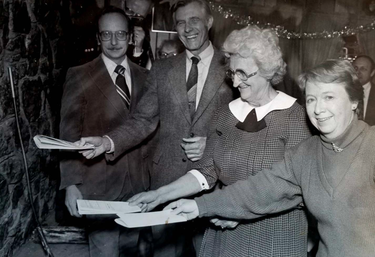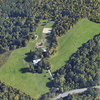The Heldeberg Workshop digs into the human history of its ‘magical’ land
— Photo from “Heldeberg Workshop: Cultural Landscape Report”
In 1986, from left, Alvin Breisch, Bill Morrison, Frieda Saddlemire, and Corinne Weeks ceremoniously burn the mortgage for the purchase of The Land used by the Heldeberg Workshop. “I’m just amazed looking back on the history of The Land,” said Weeks on Wednesday.
NEW SCOTLAND — The Heldeberg Workshop is delving into the history of its land.
Workshop board members and supporters listened to an online presentation Wednesday by Walter Richard Wheeler, senior architectural historian at Hartgen Associates.
A year ago, the workshop, a not-for-profit chartered by the state’s Board of Regents that offers kids summertime “adventures in learning,” was awarded an $8,000 grant by the Preservation League of New York State to fund a cultural landscape report.
Wheeler produced a 159-page report, which workshop leaders discussed printing and selling.
“I tried to pull together as much information as I could, particularly on the 19th-Century occupants,” said Wheeler.
“It’s a gift … We’ve learned so much,” said Dorothy Matthews, who chairs the workshop’s development committee. “It’s given us so much food for thought on what we can do.”
She asked Wheeler about his recommendation that some of the sites might be eligible for national historic status.
“Yes, as an archaeological site,” said Wheeler, giving them an overview of that process.
Several people described the workshop land as “magical.”
“We hear that a lot,” said David Wallingford, who chairs the workshop’s board. “This is the place dreams are made of.”
The 237 acres that make up the workshop property include 20 miles of hiking trails, a pond, a wetland, a waterfall, meadows, and the slope of the escarpment, providing access to diverse ecological and geological sources.
That property is part of the Helderberg Conservation Corridor, protected through the Mohawk Hudson Land Conservancy. The workshop’s land is part of a 3,700-acre corridor, stretching from the Black Creek Marsh to John Boyd Thacher State Park.
“Founded in 1961,” writes Wheeler at the start of his report, “The Heldeberg Workshop has occupied ‘The Land’ as the members of its community reverentially refer to the property under their stewardship, since 1966. A spiritual relationship between this community and The Land has developed during the course of more than 55 years. The Land contains a widely varied landscape that has inspired volunteers, educators and students for three generations.”
Ancient history
Wheeler begins his report with background history on Native Americans, noting that before the arrival of Europeans, Albany County was inhabited by the Algonquian, the Mohican, and the Mohawk Native American tribes. Before that, he writes, based on archaeological information, 12,500 years ago, Paleo-Indians had migrated to the area.
Early to Middle Archaic groups emerged 7,000 to 10,000 years ago. “Similar to Paleo-Indians,” Wheeler writes, “these were highly mobile people that left projectile points and other tools scattered throughout the landscape and little archeological evidence of their habitations.”
During the second half of the Late Archaic period, 3,300 to 4,500 years ago, indigenous groups started to make base camps. The Woodland Period, which lasted from 3,000 years ago until Europeans arrived, “is marked by increased sedentism, population density, and the introduction of pottery,” Wheeler writes.
“The final pre-contact stage in the Northeast,” he goes on, “was characterized by continued population expansion and the eventual development of the Iroquois Confederacy and Mohican people, as well as other unified tribes that were later encountered by European settlers.”
Euro-American settlers
After Henry Hudson’s exploration and the establishment of Fort Orange, traders, but not families, moved to the area that is now Albany County.
In 1629, the States General passed a Charter of Privileges and Exemptions, which permitted the granting of patroonships to foster settlement in the colony. Killian Van Rensselaer, an Amsterdam diamond merchant, was a leader of this action, which required the settlement of 50 families within four years.
He was granted a vast tract extending along both sides of the river for 24 miles and running another 24 miles east and west of it and encompassing Fort Orange. He then was required to acquire title to the lands from the Mahicans.
In 1630, the first group of farmers to arrive in Rensselaerwyck were settled outside the walls of Fort Orange.
Wheeler details the settlement of what is now New Scotland before getting to the first Euro-American settler on the Heldeberg Workshop land, Gerrit Seger Jr.
Seger built a house on the land he leased from the patroon, which was later leased by Jacob Cooper. Seger married Wyntje Oliver in Albany on July 15, 1757. Both the bride and the groom were described as “from Albany County” in the records of the Dutch Reformed Church of Albany, Wheeler reports.
On Nov. 10, 1766, Jacob Cooper leased the 127-acre farm from the patroon, Stephen van Rensselaer.
“Although the Coopers seem to have generally lived out their lives on the farm without much incident,” Wheeler writes, “a significant event occurred in June 1779, when Jacob Cooper shot and killed one of a party of robbers who had been terrorizing the neighborhood.
“Cooper’s son-in-law John Wheeler addressed the Albany Committee for Detecting Conspiracies, reporting that the robbers had been at Cooper’s house on 19 June, ‘and that in their attempting to break into the House, the said Jacob Cooper had shot and killed one of them, and [Wheeler requested]... us to send a Scout to that Quarter to go in Search of the Said Robbers.’”
Wheeler told the workshop group on Wednesday, “It wasn’t clear to me if there was any legal consequence for Cooper having shot the fellow.”
Cooper’s 1813 will bequeathed his property and farm equipment to his two sons, and his furniture and farm animals to his three daughters. Wheeler goes on to trace the history of the property from census records and wills as well as cemeteries and marriage records through several families — DeFreest, Hallenbeck, Houghton, and Crounse among them.
Workshop history
An equally detailed history of the workshop then follows, beginning with Jean Pauley — unable to answer her son’s science questions — who led three other “founding mothers” in 1966 to set up summer classes in Voorheeaville’s high school.
In 1967, the workshop board voted to lease the Aaron Crounse farm with an option to purchase The Land for $100,000 within one year.
Wheeler details at great length the workshop’s many challenges and successes as its programs grew over the years. He also has a long section, with many pictures, of structures the workshop has built, including a series of buildings meant to replicate Iroquois longhouses as well as teepees that were used by western tribes.
The report details, too, the “cultural resources” of The Land, starting with its geology and continuing through the various archaeological sites such as Cooper house and what might be a lime kiln site as well as the Houghton family cemetery, stone walls, and several “wolf” trees.
One of the people listening to Wheeler’s presentation on Wednesday, Marilyn Pusatere, asked what a wolf tree is.
Chris Albright, who is well versed in local history, had identified the “wolf” trees for Wheeler, he said, adding that they are large trees left as landmarks and can be used to shelter pasture animals. Some traditions ascribe spiritual attributes to them, Wheeler said.
His report describes them as “large trees, whose size indicates that they were part of the forest that preceded agricultural exploitation of The Land beginning in the middle of the 18th century … These trees tend to be long-lived species such as oak, and some of them may have been referenced in early deeds or surveys.”
“I myself hadn’t heard it before,” said Wheeler of the term wolf tree
Many watching the presentation recognized the picture of the wolf tree that Wheeler projected: one called it “the bee tree” while another said it stood on the boundary of the Cooper farm.
Albright, who was watching the presentation, read an explanation of the term’s derivation from the Heritage Conservancy: A tree that is older than surrounding trees with wide-spreading branches. The terminology is thought to have originated from foresters in the late 1900s who believed that these old, massive trees were devouring too much space and sunlight; as a result, they were often eliminated from the landscape, similar to the wolves that were being hunted down for consuming too many forest resources.
Wheeler concluded his presentation with a recent video of children at the Helderberg Workshop dancing around a maypole in front of the new Dick Weeks Theater Building.
The children, each holding a ribbon, wove in and out among one another as they circled the colorfully painted pole.


